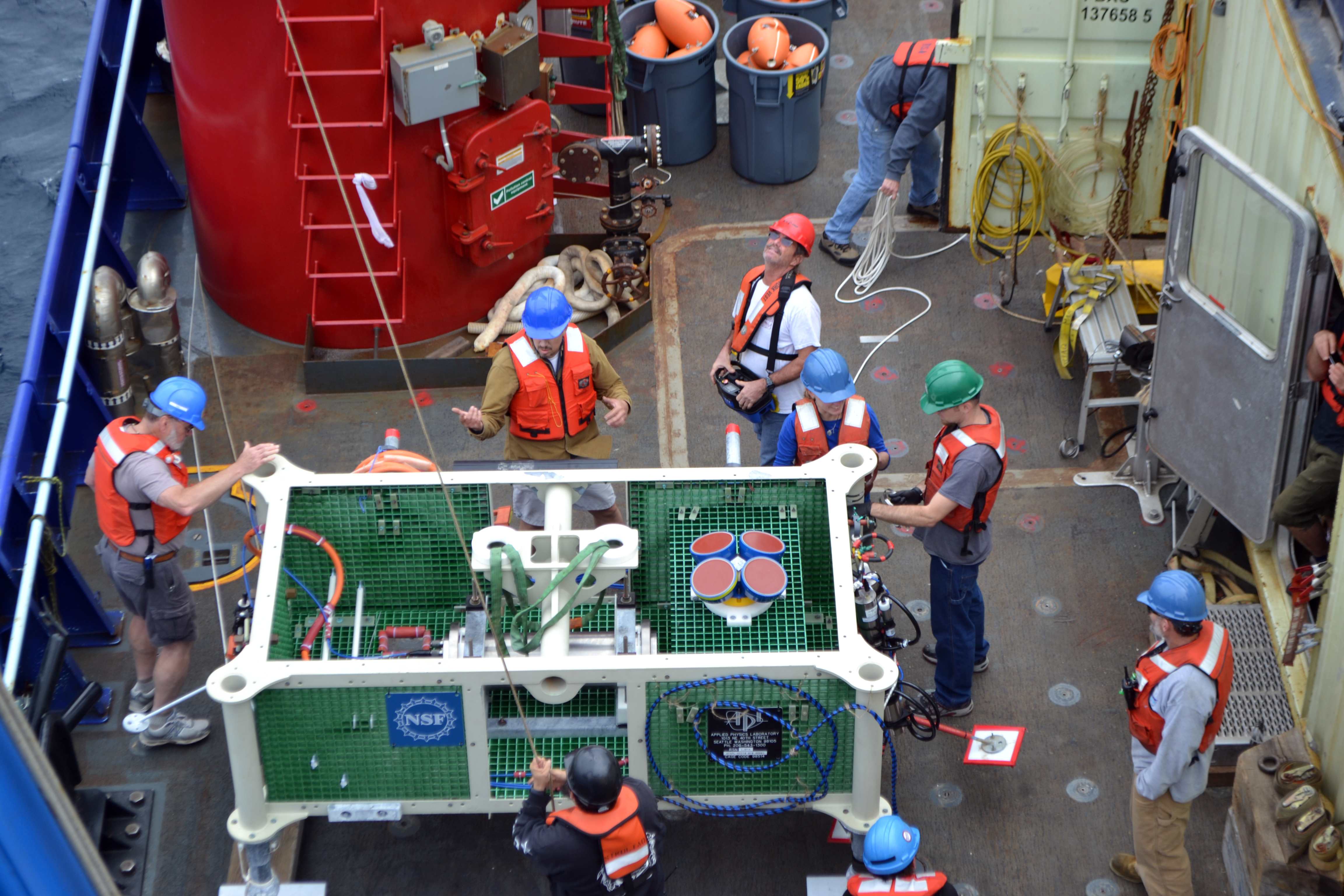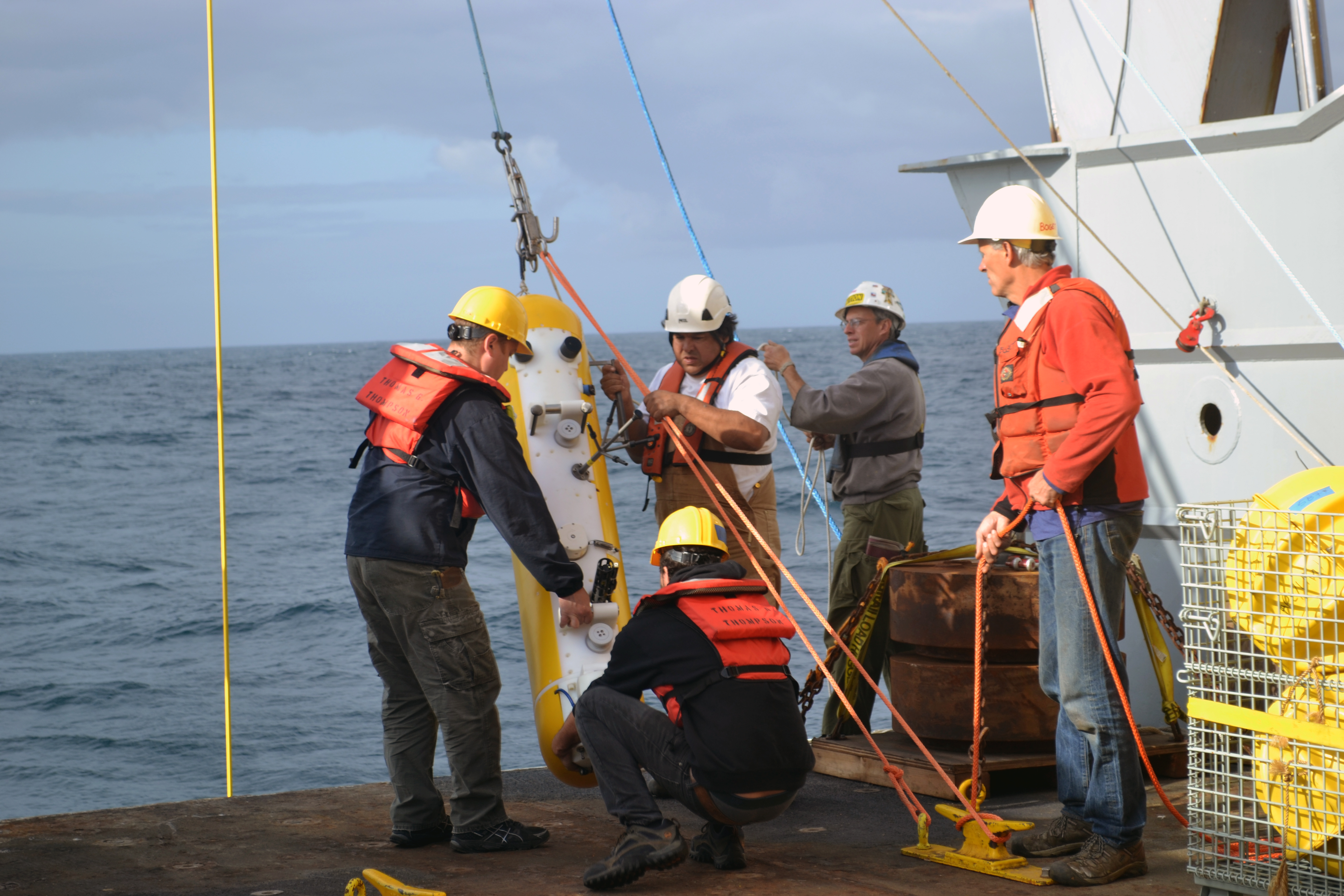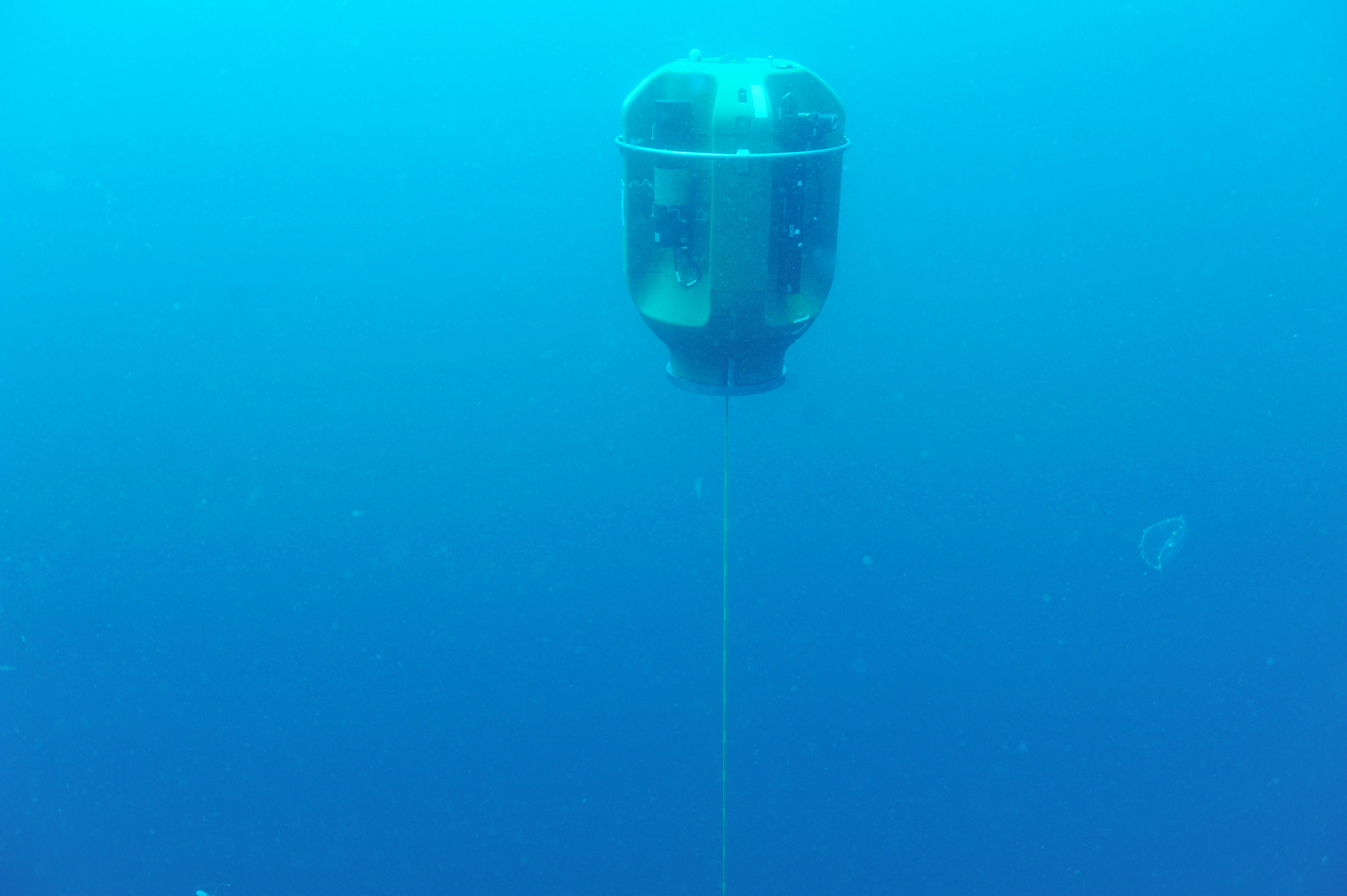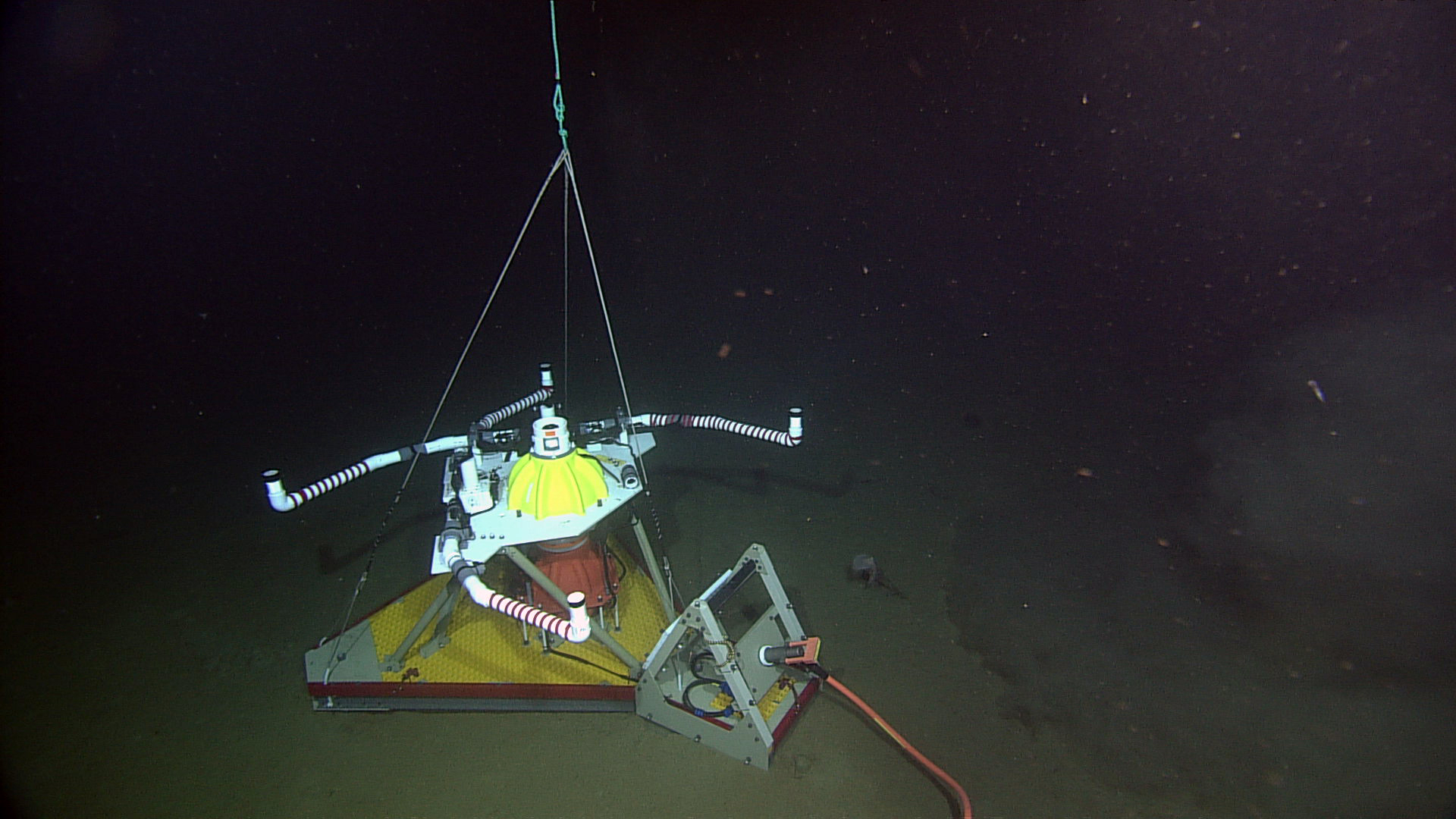Image Archive





























The 12 ft across platform on the Slope Base Shallow Profiler mooring is home to a variety of fauna, thriving in the nutrient-rich currents. Credit: UW/NSF-OOI/WHOI; V20.

A 'Big Red' Jellyfish swims past Jason at the Slope Base site ~ 68 miles offshore. Credit: UW/NSF-OOI/WHOI. V20.

Small fish hover around the top float for the Deep Profiler Mooring at Slope Base. Here, Jason removes the acoustic beacon following cleaning of the mooring cable.

Jason moves into position to clean the Deep Profiler cable at Slope Base. The instrumented DP vehicle is in the background. Credit: UW/NSF-OOI/WHOI; V20.

Chief Scientist B. Philip and engineer I. Borchert process water samples from the Slope Base site. Credit: University of Washington. V20.

A rattail investigating the newly deployed CTD and optical attenuation/absorption tripod at Slope Base. Photo Credit: UW/NSF-OOI/WHOI, V19

Sea anemones attached to a power cable on the Slope Base junction box. Photo Credit: UW/NSF-OOI/WHOI, V19

A fringed sea cucumber next to the Slope Base junction box in 2019. Photo Credit: UW/NSF-OOI/WHOI, V19.

Mysterious fish prowling around the Slope Base CTD deployment site. Possibly the snailfish Genioliparis ferox. Photo Credit: UW/NSF-OOI/WHOI, V19.

A rattail fish (aka Grenadier) at the Slope Base site, with parasitic copepods attached to its back. Credit: UW/NSF-OOI/WHOI, V19.

A rattail fish (Grenadier) investigates two pressure sensors at 9500 ft water depth at the sedimented Slope Base site. The one in the background has been equilibrating since 2017 on the seafloor. Venus fly-trap like anenomies have colonized the cables that allow data to flow to shore in real-time, and a feeding sea star is on the dusty, 2014 sensor. Credit: UW/NSF-OOI/WHOI, V18.

An octopus at 9500 ft beneath the oceans' surface finds a home by the leg of one of the Cabled Array junction boxes at the Slope Base site. Credit: UW/NSF-OOI/WHOI, V18.

A deep sea fish hangs out at Slope Base site at 2900 m water depth (~9500 ft). Credit: UW/NSF-OOI/WHOI, V18.

An instrumented "Platform Interface Assembly" from the Slope Base site is recovered onto the deck of the R/V Revelle during the OOI-NSF Cabled Array expedition lead by the University of Washington. The platform was attached to a 7,000 lb, 12 ft across mooring platform at 200 m beneath the suface. Attached to the cable it host 18 instruments sending live data to shore 24/7. Credit: M. Elend, University of Washington, V18.

Brittle stars and a scale worm recovered from the winched Science Pod on the Shallow Profiler Mooring at Slope Base. Credit. B.-Y. Lee, University of Washington.

An HPIES instrument is being installed off the starboard side of the R/V Sikuliaq ~ 125 km offshore Newport Oregon near the base of the Subduction Zone. This instrument utilizes a bottom pressure sensor, an inverted echosounder and a horizontal electrometer to provide insights into the vertical structure of current fields, near-bottom water currents, and water properties including temperature, salinity, and specific volume anomalies. It was built at the Applied Physics Laboratory. Credit: M. Elend, University of Washington, V16.

The Shallow Profiler Mooring 12-ft across, 7 ton platform hosts a new Science Pod (left) and Platform Interface Assembly (PIA, right) installed on Jason Dive J2-917 as part of the annual maintance operations for these moorings. The 'mother' platform sprouts a variety of life that was not present last year when we turned the Science Pod and PIA. Credit: UW/OOI-NSF/WHOI; V16.

The ROV Jason plugs in the low-power junction box 9500 ft beneath the oceans surface at the Slope Base site. Credit: UW/OOI-NSF/WHOI, V16.

The engineeing team from the Applied Physics Laboratory at the UW and the crew of the R/V Sikuliaq prepare the low-power junction box for installation at the Slope Base site near the Cascadia Margin, 9500 ft beneath the oceans' surface. Credit. M. Elend, University of Washington, V16.

A very large anemone and octopus call the anchor of the Slope Base Shallow Profiler Mooring home. Credit: NSF-OOI/UW/ISS; V15 ROPOS Dive R1848.

The Deep Profiler installed July 22, 2015 at the Slope Base site is caught profiling at a water depth of 2775 m beneath the ocean's surface on the mooring cable during ROPOS Dive R1855. Credit: NSF-OOI/UW/CSSF; V15.

The instrumented Deep Profiler is about to be attached to the mooring cable at the Slope Base Site (water depth 2900 m) during Leg 2 of the NSF-OOI-UW VISIONS'15 expedition aboard the R/V Thompson. Credit: Mitch Elend, University of Washington, V15.

Tim McGinnis from the UW Applied Physics Laboratory prepares the docking station for the Slope Base Deep Profiler that was installed during Leg 2 of the NSF-OOI-UW Cabled Array VISIONS'15 cruise. Credit: Mitch Elend, University of Washington, V15.

The top of the Deep Profiler mooring at the Slope Base site is marked by a large syntactic foam float. This was installed during Leg 2 of the NSF-OOI-UW Cabled Array VISIONS'15 expedition. Credit: NSF-OOI/UW/ISS; V15 - ROPOS Dive R1855.

The Oregon Slope Base Shallow Profiler, engulfed in soft sunlight, rises to ~5 m beneath the ocean's surface. It is measuring nutrients, dissolved oxygen, seawater acidity, temperature, chlorophyll, and carbon dioxide concentrations at high temporal and spatial resolution, controlled from ~70 miles onshore through the Internet at the University of Washington. Credit: NSF-OOI/UW/CSSF; V15.

An octopus clings to a mooring chain at ~9500 ft water depth near the toe of the Cascadia Margine off of Newport, Oregon. UW/NSF-OOI/CSSF; V15.

This strange fish, Genioliparis ferox (Stein), was first described in 1978 from a single specimen and never seen afterwards. It was imaged at 2901 m at the Slope Base Site during ROPOS Dive R1757. G. ferox is a ferocious mid-water predator, with many sharp teeth. Credit: UW/NSF-OOI/CSSF; Dive R1757; V14.

The Horizontal Electrometer-Pressure-Inverted Echosounder (HPIES -HPIESA101) installed at the Slope Base site. Photo credit: NSF-OOI/UW/CSSF; Dive R1757; V14.
- Anemone
- Animal
- Arthropod
- ASHES
- Axial
- Axial Base
- Axial Biology
- Axial Caldera
- Bacteria
- Basalt Lava
- BEP
- Biofouling
- biolgoy
- Biology
- Camds
- Camera
- Camhd
- Central Caldera
- Ciliates
- Cnidaria
- Coastal Biology
- Crab
- Deep Profiler Mooring
- Dive Highlights
- Eastern Caldera
- Echinoderms
- Endurance Array
- Engineering Team
- ENLIGHTEN 10
- Exploratorium
- Fish
- Geology
- HD Camera
- HPIES
- Hydrate Ridge
- Hydrates
- Hydrophone
- Hydrothermal Vents
- Illustration
- Inshore 80 Meters
- Instrument
- International District
- J-BOX
- Jason
- Jellyfish
- Junction Box
- K12
- Lava
- Mollusk
- Moorings
- Nodes
- Nudibranch
- Octopus
- OOI
- Oregon Offshore
- Oregon Offshore 600 m
- Oregon Shelf
- Oregon Slope Base
- People
- PN1B
- PN1D
- Polychaetes
- PPSDN
- Primary Node
- RASFL
- ROCLS
- ROPOS
- ROPOS Dives
- ROV Team
- RV Revelle
- RV Sikuliaq
- RV Thompson
- Salp
- Sample
- SC13
- Science Team
- Sea Cucumber
- Sea Star
- Sea Urchin
- Seafloor
- Seismometer
- Sensors
- Shallow Profiler Mooring
- Shark
- Shipboard
- Shore Station
- Slope Base
- Smoker
- Soft Coral
- Southern Hydrate Ridge
- Sponge
- Squid
- Students
- Students & Guest Participants
- Tmpsf
- Tubeworms
- VISIONS 11 Leg 1
- VISIONS 11 Leg 2
- VISIONS 11 Viewers
- VISIONS 13
- VISIONS 14
- VISIONS 15
- VISIONS 16
- VISIONS 17
- VISIONS 18
- VISIONS 20
- VISIONS 22
- VISIONS 23
- Visualization
